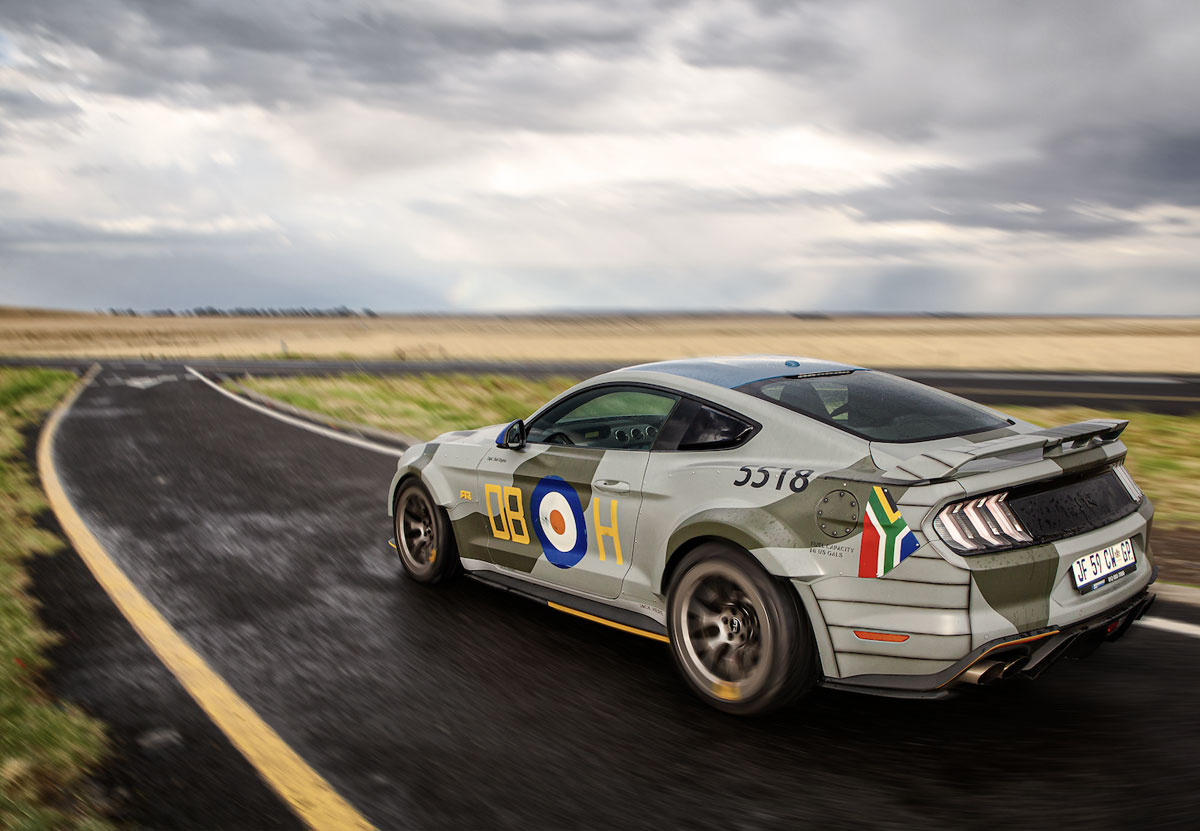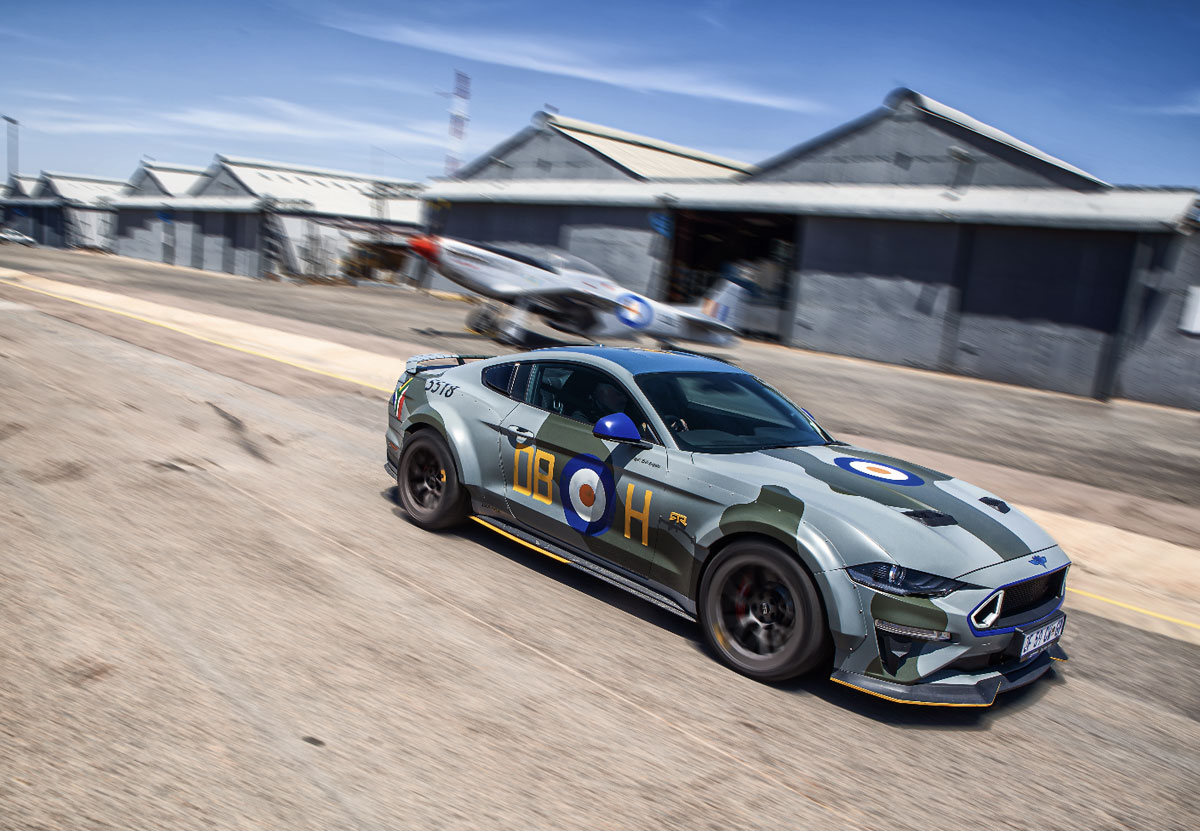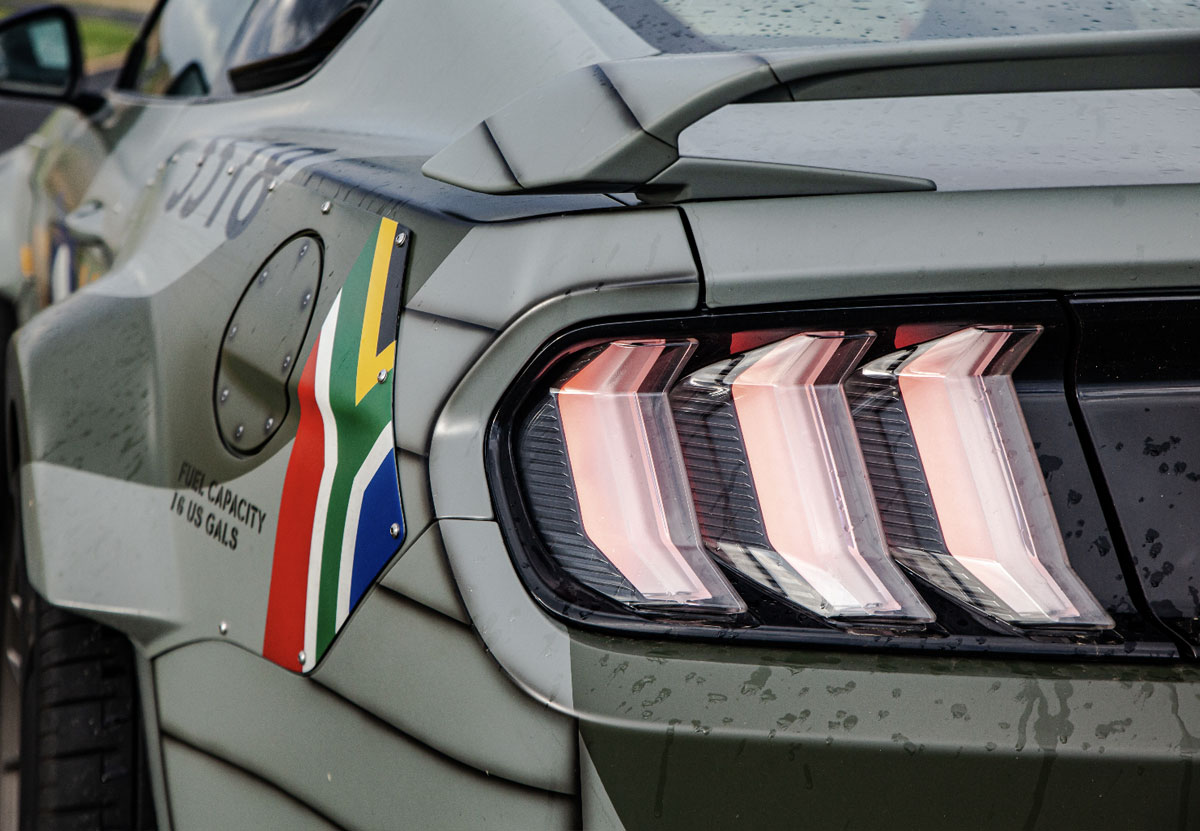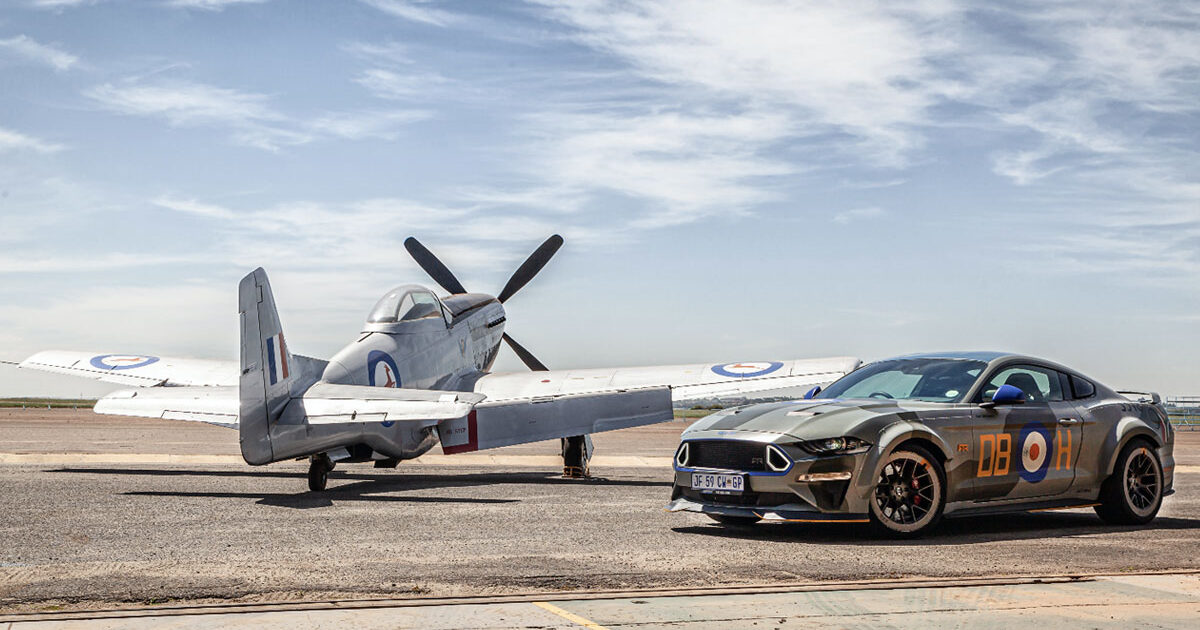The recently launched Ford Performance approved and enhanced RTR Spec 5 is now the fastest production Mustang in Mzansi. We took the camouflaged beast for a quite different road trip to meet its iconic flying namesake, Mustang P51 number 325 of the South African Air Force; according to legend the fastest ’Stang in Korea …
Dressed in its special camo kit the Vaughn Gittin Authentic RTR Vehicles Spec 5 widebody (apparently the first of its kind in the world!) looks lean, mean, and extremely dangerous – as if it just escaped from the latest sim versions of **Forza Motorsport** or **Call of Duty** …
Officially approved by Ford Performance and distributed locally by Performance Centre South Africa, the RTR performance package (incredulously, it stands for “Ready to Rock!”) was created by American drift king Vaughn Gittin, also known as JR.
His vision of the Mustang pony car features modern and aggressive styling combined with the most extreme gofaster parts from Ford Performance and our “Spitfire DBH” steed – with its British WWII camouflage scheme imitating the colours and identification of the Royal Air Force (RAF) Spitfire Mk. IX flown by Capt. Bob Rogers in 1943 – really looked the part.
The special Mustang is part of a project involving ten RTR Vehicles conversions to raise money to rebuild the last remaining South African Air Force (SAAF) Spitfire, number 5518 (visit https://warriorsofthesky.co.za/ for more detail).
So, a Mustang is used to rebuild a Spitfire? Then, how about the proud history of the SAAF flying Mustang ’planes in WWII and in Korea? With this in mind, we decided to pay homage to the brave airmen of SAAF 2 Squadron, the Flying Cheetahs, who seven decades ago were deployed in Korea as part of the UN force fighting against North Korea.
How? By taking the special Mustang RTR on a quite different kind of road trip; to visit the North American Mustang P51 on display in the SAAF Museum at Air Force Base Swartkop in Pretoria.
Interestingly, 70 years ago the initial plan was to equip 2 Squadron with Spitfires but this was rescinded in favour of using ’planes already in the theatre – the Mustang F51s operated by the 18th Fighter-bomber Wing of the United States Air Force.
The squadron landed in Korea in September 1950 and flew their first mission in November. Also, Bob Rogers was part of the South African contingent flying Mustangs in the conflict, and later he would become Chief of the South African Air Force …

RTR road trip
Our little excursion meant driving the monstrous RTR from Air Force Base (AFB) Ysterplaat in Cape Town – a symbolic starting point, as a Canadair Sabre Mk 6, in its original silver colour scheme as later used by the SAAF in the Korean conflict, is preserved here – all the way to Tshwane, a 1 554 km trip on the N1 and N12 …
Now, the P51 (its designation changed to F51 in Korea) was developed primarily as a long-range fighter to escort Allied bombers over Europe but the same cannot be said about its automotive namesake. On the contrary. With its Roush/Ford Performance TVS supercharged 5.0-litre V8 and only a “16 US gallons” (60 litres) fuel tank, we were concerned about consumption and reach on the long road …
Also, there is nothing subtle about the RTR Spitfire, as confirmed by its raucous startup and riotous engine noise. A prod of the loud pedal unleashes a spine-tingling NASCAR V8 shriek … making it crystal clear this ’Stang is no ordinary stallion but rather a thoroughbred racehorse with immense performance potential.
Power delivery is a stonking 540 kW plus, with over 850 Nm of peak torque –pushing the RTR from 0-100 km/h in under five seconds and a (soft limited) top speed of 260 km/h. To experience this firsthand, select race mode with launch control, brace yourself against the Recaro seat, bury the throttle … and feel the awesome kick as the RTR takes off like a scalded cat.
With the tyres struggling for grip, even in higher gears, the sensation of speed and sound will put a smile on your face, at least, if not making you laugh out loud …It actually feels quicker behind the wheel, and only the slightest touch of the accelerator is needed to dispatch of slower traffic in a whiff.
(For some perspective, the Packard-built 12cylinder liquid cooled Merlin engine used in the Mustang P51 delivered 1 111 kW at 3 000 rpm and gave the fighter a top speed of 708 km/h, and it had a range of 2 650 km …)
Yet, despite the huge muscle of the RTR, its low, menacing stance and huge, staggered tyres with RTR Tech 7 rims, ride quality is surprisingly good, mostly due to the MagneRide damping system. The bespoke suspension, consisting of RTR Tactical Performance lowered springs, adjustable front and rear sway bars, and adjustable shocks and struts was firm but pliant.
It soaked up road imperfections much better than expected (in normal mode), and the stopping power supplied by the upgraded braking system made our trip even more pleasant than expected. However, it was not stealthy at all, even in a camouflaged car … Everywhere we stopped, bystanders wanted to have a look, and inevitably they encouraged you to rev the engine and do a smoky departure …
The road flew by, and two fuel stops and many litres later we entered Kimberley, now regarded as the ‘cradle of aviation’ in South Africa, as the first flying school in the country was established at nearby Alexandersfontein. We passed by the (closed) Pioneers of Aviation Museum before commencing the last leg of our journey towards Tshwane.
On this sweepy stretch we again lamented the only real drawback of an otherwise great package – the slightly slow-shifting ten-speed auto transmission. With so many gears, one could sense the confusion of the software trying to match throttle input to revs, leading to microseconds of delay. Luckily, using the steering-wheel-mounted paddles alleviates this frustration.

Mustang Meet
The next day, having received permission from the SAAF Museum, we took our camoMustang to meet its airborne counterpart. While this particular P51, smartly presented in SAAF Korean War colours, has its own interesting history, the legacy of its forebears with the number 325 is quite remarkable – and mostly due to the SAAF ground personnel in Korea.
You see, the SAAF ground crew serving in Korea were volunteers and mostly WWII veterans, and therefore serviceability in 2 Squadron was better than that of the USAF squadrons in the wing. So, when faced with shortage of aircraft, the ground crew cannibalised three written-off Mustang F51s to build one serviceable ’plane.
The dismantled craft included the first Mustang number 325, named ‘Pappasan’ and the ground personnel rebuilt the aircraft from components salvaged from the other wrecks. The work took a month and as the SAAF paid for aircraft received, this particular ’plane was free to the squadron. The resulting hybrid was again numbered 325 (Pappasan II) and according to legend it was evidently the fastest Mustang in Korea.
In honour of this iconic Mustang, the example acquired by the SAAF Museum in 1987 and restored over a period of 12 years is now the third Mustang to bear the number 325. It is now named Patsy Dawn – after the aircraft flown by 2 Squadron pilot Tubby Singleton in Korea when he became the youngest winner of the American Distinguished Flying Cross (DFC).

Hybrid horses
Much like Mustang P51 number 325 the RTR Spec 5 derivative of this popular pony car of Ford is a hybrid – using the best equipment Ford Performance can offer and combining it with functional, bespoke dynamic components and eye-catching aero parts to create the fastest ’Stang in the West (sorry, Mzansi).
An RTR conversion does not come cheap, though, as a Spec 3 conversion on a 5.0 Mustang GT with supercharger will set you back R700 000, and this does not include the cost price of the donor car (priced from R1 023 700) … Still, all the special bits, 60% more power and 56% more torque transforms the car …
These tuning options are also supported by Ford of South Africa and are available through the dealer network, with a Ford Protect drivetrain warranty of three years/60 000 km, and a less than a year old V8 Mustang can also serve as donor car. A word of warning, though, while the RTR has prodigious grip, it still stays a Mustang, with its associated handling characteristics.
On the limit, you can feel it move at the back, and yes, an overcook in corners can be easily corrected. It is fun … and safe. However, beware the torque output. If not respected, it may easily spoil your day. Nevertheless, our fast and furious trip to meet up with Mustang number 325 was memorable.
**Our thanks to Performance Centre Africa for making the RTR available and thank you to the SAAF Museum for granting us permission to photograph the P51.
Text: Ferdi de Vos
Images: Ryan Abbott/Ford Performance


